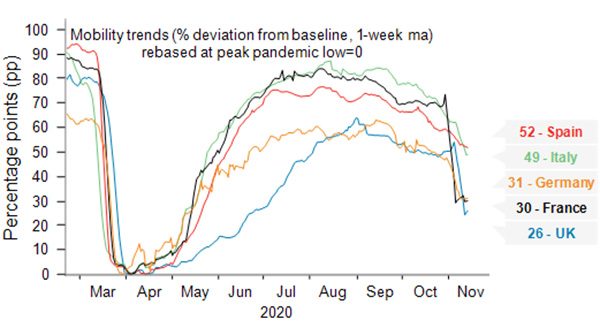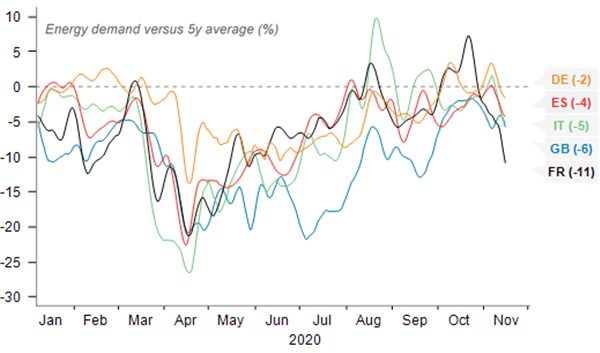In its Global Outlook 2021: Fearless Asymmetry report, Markets 360, BNP Paribas Global Markets’ strategy and economics team examines the shape and the drivers for the global outlook in the coming year.
“The
prospect of a vaccine – if not several – being widely distributed in H2 2021
will enable corporates and consumers to envision a post-Covid world at last,
reviving investment and spending plans”, says Olivia Frieser, Global Head of
Markets 360. “This sets the stage for a strong economic recovery”.
Fearless asymmetry
2021 is set to be dominated by asymmetry in data, central bank policy and market reaction. Macroeconomic indicators risk staying on a downward slope in Q4 2020 and Q1 2021, as the economic drag from the virus could be deeper and more prolonged than expected. However, from H2 2021 they look more balanced, and a smooth vaccine roll-out (see table below) could even accelerate the demand catch-up.Probability of functional end to Covid-19 pandemic in US by quarter
This table illustrates the roll-out of a vaccine, taking the US as an example. Timelines may vary, but this is also a template for Europe and a key assumption in our forecasts.
Early (Q2 2021)
|
Baseline (Q3/Q4 2021)
|
Late (2022 or later)
|
There is also an asymmetry in how markets might interpret data now that vaccines are in sight, with weak data viewed as less informative and potentially backward looking, while positive data would reinforce the prospect of a solid post-vaccine rebound.
Central banks, meanwhile, are likely to react asymmetrically to the data in order to revive inflation, reacting swiftly to any negative news but more cautiously to positive developments. A key difference from previous crises is that fiscal and monetary policy is unlikely to tighten materially for a long while yet in advanced economies, though some emerging markets, such as Brazil, South Africa and Russia, have less room for continued fiscal expansion. In short, for markets the glass looks half full, and for central banks it is half empty.
Solid rebound after bumpy start
Against this backdrop, the global economy is set to slow into the year end as output contracts again in countries with renewed lockdowns and given the scope for data to disappoint expectations, although BNP Paribas alternative data analysis, such as mobility and energy demand, suggests the drag will be smaller than in the wake of the first Covid-19 wave (see figures). The prominent exception is China, which has already returned to above pre-pandemic levels, though it is still below the pre-crisis trend.
Next year, the broad roll-out of a Covid vaccine will likely drive a forceful, if uneven, rebound, with most economies seeing above-trend growth rates from H2 2021 into 2022. However, GDP is likely to end 2021 below its end-2019 level in most economies due to enduring effects from the Covid-19 shock.
In some cases, such as Japan, these effects could persist for much longer. In the UK, prolonged uncertainty around Brexit is likely to weigh on growth. Within emerging markets, the 2021 rebound in emerging Asia and, to a lesser extent, CEEMEA ex. South Africa, is set to be larger than the drop seen in 2020. Latam economies are likely to lag the EM average.
Inflation low for longer but not forever
In the short term, we expect uncertainty from successive waves of infection, and excess economic slack, to dampen spending and investment, which would continue to hit demand, resulting in continued net disinflation. In the medium term, although we expect some scarring from the pandemic, the arrival of a vaccine and loosened social restrictions are set to revive demand and supply.While structural forces will to continue to exert downward pressure on prices in developed markets, BNP Paribas Markets360 is confident that the closing output gap and a strong dovish message from central banks will allow inflation to return toward targets within three to five years.
Market drivers
Significant monetary and fiscal easing in 2020 increased breakeven inflation and reduced real yields – the two variables that BNP Paribas’ MarFA™ (market factor analysis) identifies as the main factors behind financial market direction – such that the two almost offset one another. These two factors will be important drivers of both financial markets and associated risk scenarios in 2021.A year of green recovery
In 2021, the BNP Paribas sustainability team highlights the importance of COP26 in Glasgow in November, and whether major emitters can reach bilateral carbon-trading agreements. The EU is likely to continue to lead the transition to a low-carbon economy in 2021 with the roll-out of its EU Taxonomy and a continued rise in sovereign green issuance, while energy demand in China and the US is likely to pit the two in a race to develop battery technology, spurring green innovation.
To learn more about Markets 360 Strategy and Economics from BNP Paribas, click here.
BNP Paribas does not consider this content to be “Research” as defined under the MiFID II unbundling rules. If you are subject to inducement and unbundling rules, you should consider making your own assessment as to the characterisation of this content.
Legal notice for marketing documents, referencing to whom this communication is directed.

